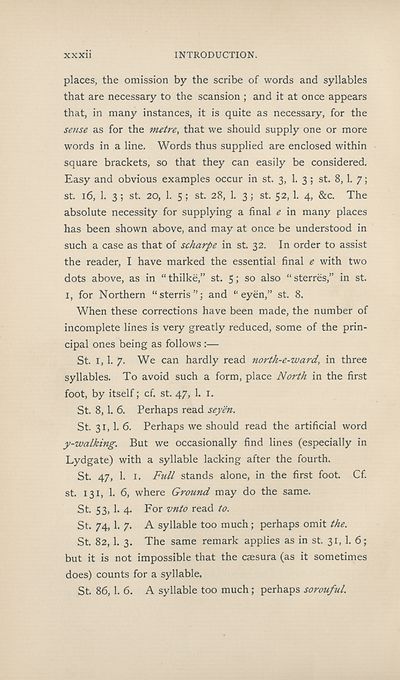Scottish Text Society publications > New series > Kingis quair; together with A ballad of good counsel
(42)
Download files
Complete book:
Individual page:
Thumbnail gallery: Grid view | List view

XXX11
INTRODUCTION.
places, the omission by the scribe of words and syllables
that are necessary to the scansion ; and it at once appears
that, in many instances, it is quite as necessary, for the
sense as for the metre, that we should supply one or more
words in a line. Words thus supplied are enclosed within
square brackets, so that they can easily be considered.
Easy and obvious examples occur in st. 3, 1. 3 ; st. 8, 1. 7;
st. 16, 1. 3; st. 20, 1. 5; st. 28, 1. 3; st. $2, 1. 4, &c. The
absolute necessity for supplying a final e in many places
has been shown above, and may at once be understood in
such a case as that of scharpe in st. 32. In order to assist
the reader, I have marked the essential final e with two
dots above, as in “ thilke,” st. 5 ; so also “ sterres,” in st.
i, for Northern “sterns”; and “ eyen,” st. 8.
When these corrections have been made, the number of
incomplete lines is very greatly reduced, some of the prin¬
cipal ones being as follows :—
St. 1, 1. 7. We can hardly read north-e-ward, in three
syllables. To avoid such a form, place North in the first
foot, by itself; cf. st. 47, 1. 1.
St. 8, 1. 6. Perhaps read seyen.
St. 31, 1. 6. Perhaps we should read the artificial word
y-walking. But we occasionally find lines (especially in
Lydgate) with a syllable lacking after the fourth.
St. 47, 1. 1. Full stands alone, in the first foot. Cf.
st. 131, 1. 6, where Ground may do the same.
St. 53, 1. 4. For vnto read to.
St. 74, 1. 7. A syllable too much ; perhaps omit the.
St. 82, 1. 3. The same remark applies as in st. 31, 1. 6;
but it is not impossible that the caesura (as it sometimes
does) counts for a syllable.
St. 86, 1. 6. A syllable too much ; perhaps sorouful.
INTRODUCTION.
places, the omission by the scribe of words and syllables
that are necessary to the scansion ; and it at once appears
that, in many instances, it is quite as necessary, for the
sense as for the metre, that we should supply one or more
words in a line. Words thus supplied are enclosed within
square brackets, so that they can easily be considered.
Easy and obvious examples occur in st. 3, 1. 3 ; st. 8, 1. 7;
st. 16, 1. 3; st. 20, 1. 5; st. 28, 1. 3; st. $2, 1. 4, &c. The
absolute necessity for supplying a final e in many places
has been shown above, and may at once be understood in
such a case as that of scharpe in st. 32. In order to assist
the reader, I have marked the essential final e with two
dots above, as in “ thilke,” st. 5 ; so also “ sterres,” in st.
i, for Northern “sterns”; and “ eyen,” st. 8.
When these corrections have been made, the number of
incomplete lines is very greatly reduced, some of the prin¬
cipal ones being as follows :—
St. 1, 1. 7. We can hardly read north-e-ward, in three
syllables. To avoid such a form, place North in the first
foot, by itself; cf. st. 47, 1. 1.
St. 8, 1. 6. Perhaps read seyen.
St. 31, 1. 6. Perhaps we should read the artificial word
y-walking. But we occasionally find lines (especially in
Lydgate) with a syllable lacking after the fourth.
St. 47, 1. 1. Full stands alone, in the first foot. Cf.
st. 131, 1. 6, where Ground may do the same.
St. 53, 1. 4. For vnto read to.
St. 74, 1. 7. A syllable too much ; perhaps omit the.
St. 82, 1. 3. The same remark applies as in st. 31, 1. 6;
but it is not impossible that the caesura (as it sometimes
does) counts for a syllable.
St. 86, 1. 6. A syllable too much ; perhaps sorouful.
Set display mode to: Large image | Zoom image | Transcription
Images and transcriptions on this page, including medium image downloads, may be used under the Creative Commons Attribution 4.0 International Licence unless otherwise stated. ![]()
| Publications by Scottish clubs > Scottish Text Society publications > New series > Kingis quair; together with A ballad of good counsel > (42) |
|---|
| Permanent URL | https://digital.nls.uk/113908799 |
|---|
| Description | A collection of over 100 Scottish texts dating from around 1400 to 1700. Most titles are in Scots, and include editions of poetry, drama, and prose by major Scottish writers such as John Barbour, William Dunbar, Gavin Douglas, and George Buchanan. Edited by a key scholarly publisher of Scotland's literary history, and published from the late 19th century onwards by the Scottish Text Society. Available here are STS series 1-3. |
|---|

